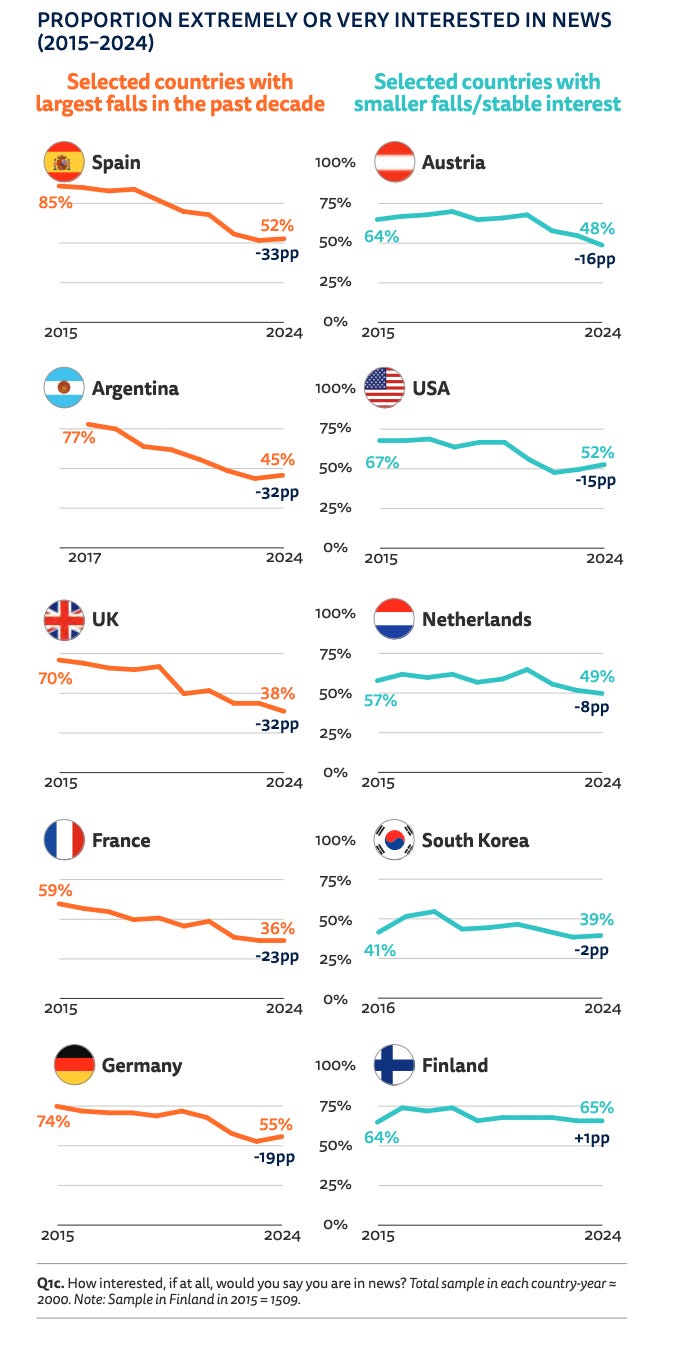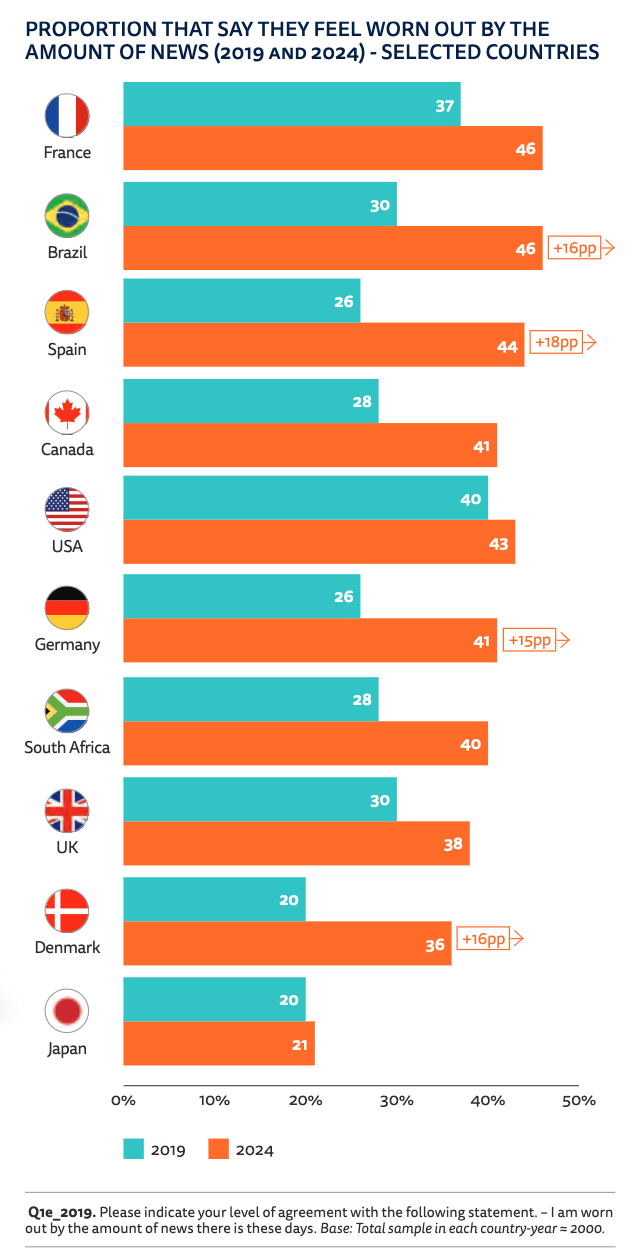You’re reading the My News Biz newsletter, which I will be sending you every other Thursday. My goal is to help you and other digital media entrepreneurs to find a viable business model that works for you. If you were forwarded this email, you can sign up here. Embarrassing to admit: I avoid (some) newsI'm part of a worldwide trend, with women and men showing different tendenciesYou’re reading the My News Biz newsletter, which I send every other Thursday. My goal is to help digital media entrepreneurs find viable business models. It’s a big event in journalism when the Reuters Institute for the Study of Journalism releases its annual Digital News Report. This year’s edition, just released on July 17, had loads of data on “news avoidance,” or people actively avoiding news. (Survey methodology here.) A confession. It’s a bit embarrassing for a journalist like me to admit it, but I avoid certain news. It began during the endless 2016 U.S. election campaign and its violent aftermath. The new president had taken office, but the old one and his allies were claiming fraud. Now we were in the territory of lawyers, judges, injunctions, lawsuits, investigations, televised shouting matches, and a flood of news and opinion. For the past three years, some opinion columnists and broadcasters have talked about almost nothing else, every single day. The attention economyWhy all this pontificating, predicting, and propagandizing? These media have business reasons for fighting for our attention, and they often drown out the public service of responsible reporting. The reason for all this noise is in the nature of our current media ecosystem. We live in the attention economy: “It refers to the range of economic activities based on people’s attention being treated as a scarce and highly desirable resource to be captured and maintained (emphasis mine).” Because attention is scarce, it is valuable. Every media organization — big or small, reputable or untrustworthy — is using every tactic at hand to engage us. They need our attention to sell ads and subscriptions, to create value for their brands so we will become loyal consumers of their products. The result of all this battle for our attention? ‘News fatigue’The Reuters study, which covered 47 media markets on six continents, shows a steady worldwide decline in “interest in the news” over the past decade. Under the headline, “Attention loss, news avoidance, and news fatigue,” the report states:
What I really dislike about most of the notifications is that they are worded in such a way as to trigger fear, anxiety, envy, or even hatred to get us to click. The motive is to show advertisers a huge number of “users”. They are not thinking about what those users might want to know or need to know. They are thinking only about their business results. And that brings us to the chart below, which maps the results of these tendencies in 10 countries on four continents. Media consumers are turning away from the news. Chart below explained. All 10 countries show a decline in “interest in news,” except Finland. Those on the left had bigger declines than those on the right. The “pp” in the chart refers to percentage points, so Spain’s -33pp means that news interest among Spanish consumers has declined by 33 percentage points over the past decade. In the list to the right, interest in news in the USA has fallen by 15 percentage points over the past decade. Why the decline?Another group of Reuters survey respondents in 10 countries was asked the following question in both 2019 and 2024:
The results show large increases in news fatigue in eight of the 10, most notably in Brazil, Spain, Germany, and Denmark. Only Japan and the USA were almost unchanged. The survey also asked respondents to explain their answer: “The sheer volume of information is overwhelming. We can be left feeling helpless in the face of another remote disaster, leaving you feeling guilty and impotent.” Male, 71, UK “There’s too much news nowadays … some are fake and some are real, but I get confused and get a headache.” Male, 27, USA The way forward, from the dataLet’s return for a moment to the first chart that showed declines in “interest in news” in 10 countries. The Reuters report notes, “Women and young people make up a significant proportion of that decline,” p. 26. I believe results from several of the survey questions suggest ways for publishers to engage more women and young people.
Astute marketing directors ought to be able to figure out ways to take advantage of these coverage gaps to attract and keep new audiences. If you need more ideas, here are suggestions from Reuters: read this excerpt from their book on news avoidance and this piece with seven practical things that journalists can do to fight it. You're currently a free subscriber to My News Biz. For the full experience, upgrade your subscription. |
EL PERIÓDICO DE LOS PERIÓDICOS. SOMOS NOTICIAS. Para publicar, contactar: aliazon.comercialyventas@gmail.com
Páginas
- Inicio
- NACIONAL ESPAÑA
- INTERNACIONAL
- BOLETINES DIARIOS
- PORTADAS
- SOCIEDAD
- POLÍTICA
- SECCIONES
- ARTÍCULOS
- ECONOMÍA
- CULTURA
- NOTICIAS TURISMO
- PERIODISTAS
- REVISTAS
- NOTICIERO
- HEMEROTECAS
- REDES SOCIALES
- EVENTOS
- CLIMA
- PUBLICIDAD
- MENÚ
- COMUNICADOS DE PRENSA
- BOLETINES INFORMATIVOS
- MUNDO RURAL
- FEMINISMO
- GASTRONOMÍA
- EMPRESAS
- EL TIEMPO
- RADIO Y TELEVISIÓN
- CIENCIA
- MOTOR
- CONSUMO
- EDUCACIÓN
- TOROS
- OPINIÓN
- BLOGS
- ELECCIONES
- PODCASTS
- PASATIEMPOS
- NEWSLETTERS
- EMPLEO
- SERVICIOS
- SALUD
- ARTE
- BELLEZA
- LIBROS
- NEGOCIOS
- MEDIO AMBIENTE
- TECNOLOGÍA
- LOTERÍAS Y JUEGOS
- MODA
- OTROS
- HORÓSCOPO
- LIFESTYLE
jueves, 20 de junio de 2024
Embarrassing to admit: I avoid (some) news
Suscribirse a:
Enviar comentarios (Atom)
ARTÍCULOS
¿Tienes información sobre alguna noticia interesante? aliazon.comercialyventas@gmail.com
ROPA Y COMPLEMENTOS ALIAZON
ROPA Y COMPLEMENTOS
OPINIÓN

Opinión y análisis // Diariocrítico.com
Artículos de Opinión | El Independiente
RSS de noticias de opinion
OPINION EL CONFIDENCIAL
Estrella Digital :: Últimas opiniones
Nuevatribuna :: Últimas opiniones
OPINIÓN-KHAMENEI
ÚLTIMAS NOTICIAS

ÚLTIMAS NOTICIAS
Últimas noticias // Diariocrítico.com
Estrella Digital :: Últimas noticias
Comentarios en: Últimas noticias
RSS de noticias de ultima-hora
PORTADAS
RSS de noticias de portada
NACIONAL ESPAÑA

Noticias nacionales | Diariocritico // Diariocrítico.com
MUNDO-KHAMENEI
CULTURA
ARTE
Arte y Cultura // Diariocrítico.com
TEATRO
Salud y vida saludable // Diariocrítico.com
SEXUALIDAD
Sexualidad y salud sexual y para disfrutar de las relaciones en pareja // Diariocrítico.com
SALUD
HISTORIA
Canal Historia // Diariocrítico.com
TURISMO
SOCIEDAD

Sociedad EL CONFIDENCIAL
LIFESTYLE
Estilo Hombre
MODA
CRÓNICA ROSA
Noticias del Corazón // Diariocrítico.com
LO MÁS LEÍDO
Lo más leido de la semana // Diariocrítico.com
CIENCIA
LIBROS
Noticias de libros, editoriales, autores y premios literarios // Diariocrítico.com
ECONOMÍA

Economía-EL CONFIDENCIAL
La actualidad económica en vivo - France 24
RSS de noticias de economia
COMENTARIOS DE ECONOMÍA
Comentarios de la Economía // Diariocrítico.com
Noticias economicas | Diariocritico // Diariocrítico.com
MERCADOS

Mercados - EL CONFIDENCIAL
EMPRESAS

Empresas - EL CONFIDENCIAL
FINANZAS








No hay comentarios:
Publicar un comentario